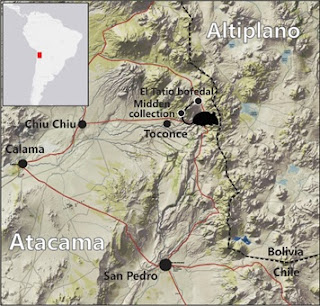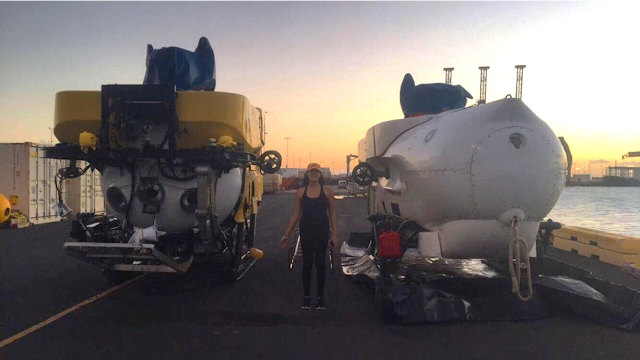Fieldwork in The Highlands of Northern Chile: a Photographic Journey
by Ignacio Jara
We started our fieldwork near the village of Toconce on the western slopes of the Chilean Andes (22°S). At about 3300 meters above the sea level (m), this area represents the upper altitudinal limits of the Atacama Desert where summer rains allow the establishment of perennial shrubs, the pasture lands for these llamas (Lama glama).
Fossil middens are packs of faecal pellets, plant and animal remains, and soil preserved in crystalized urine. Apart from their disturbing scent, they preserve a paleoenvironmental signal extending over the very brief lifespan of an individual rat. For this reason, we collected more than 30 middens such as the one pictured here. To determine the age of these smelly deposits, we will date them individually with radiocarbon techniques.
After our successful experience of collecting middens, we moved up to the Altiplano. In the image on the right, the high-Andean plateau unfolds in front of a young Pleistocene lava dome.
Despite our unsuccessful lake hunt, we retrieved two sets of peat cores from a bofedal (high-Andean peatland) near El Tatio geothermal area at 4300 m (right). Hopefully, paleorecords like this one will provide new insights into the hydrological evolution of this region. Photo courtesy of Eduardo Godoy Tapia.
Ignacio A. Jara
CEAZA Scientific Centre, Chile
If you have questions or comments concerning Ignacio's post, please leave a comment below, or send him an email. You can also connect with him on Twitter.
Preface
As the first year of my postdoc at the Centre for Advanced Studies in Arid Zones in La Serena, Chile, was coming to an end, we went on our first field trip to northern Chile. We explored the highlands of the Atacama Desert and the Altiplano (Fig. 1) in December 2019 to collect two different types of paleoecological archives: fossil rodent middens and lake sediments. These samples will become the core material for my postdoc project, which focuses on reconstructing the last 4,000 years of climate evolution of this fascinating region. |
Fig. 1. Location of the highlands of Atacama Desert and
Altiplano, Chile
|
Instrumental climate records in Chile — and the Southern Hemisphere in general — are sparse and very short in time, which implies that climate projections for these regions rely almost exclusively on brief and incomplete datasets. As such, paleoclimate studies like the one I am conducting are highly relevant today because they offer a longer-term climate context to understand current changes and trends.
After our return from the field, I spent some time reviewing the photographs taken during our trip. I was very pleased to see that the spectacular landscapes, rich biodiversity, and prominent geology we witnessed were sharply captured in our pictures. I am very happy to present a selection of these pictures complemented by brief notes describing our activities, experiences and key information taken in the field. I hope you enjoy this photographic journey!
Our journey
We started our fieldwork near the village of Toconce on the western slopes of the Chilean Andes (22°S). At about 3300 meters above the sea level (m), this area represents the upper altitudinal limits of the Atacama Desert where summer rains allow the establishment of perennial shrubs, the pasture lands for these llamas (Lama glama).
Ancient agricultural practice — still used in the highlands of northern Chile — can be seen in these cultivation terraces around Toconce village. Pre-Columbian crops such as maize, quinoa and potatoes are cultivated in stone terraces over canyon slopes. The role of environmental change in the emergence and evolution of pre-Columbian agriculture in this arid region is a topic of current research and one of the subjects of my postdoc project.
The first days of fieldwork were spent sampling fossil rodent middens. Midden collection took place in an approximately six-million-year-old (late-Miocene) ignimbrite outcrop above 3300 m. Visible at the centre of this picture as a massive white and pink plateau, this volcanic deposit forms part of the Toconce Formation at the western foot of the Altiplano. Volcanic and tectonic activity in this area extends back to the Tertiary period (66 to 2.6 million years ago).
My first rodent midden! These deposits are commonly found inside rock shelters, cracks or at the bottom of big boulders, the most common places where rodents make their nests. In arid regions like northern Chile, these remnants are preserved for thousands of years with lots of macro and microscopic organic remains including pollen, which I will use to reconstruct past climates.
Fossil middens are packs of faecal pellets, plant and animal remains, and soil preserved in crystalized urine. Apart from their disturbing scent, they preserve a paleoenvironmental signal extending over the very brief lifespan of an individual rat. For this reason, we collected more than 30 middens such as the one pictured here. To determine the age of these smelly deposits, we will date them individually with radiocarbon techniques.
A chirihue (yellow finch) of the Sicalis genus (left). This diverse group of Andean birds typically have thick, freeze-proof plumage designed to cope with mountainous conditions.
Built-in adobe (clay used as a building material) with light, yet durable wooden cactus beams — this 1675 CE Catholic church is the icon of Chiu Chiu (2400 m) and a national monument since 1951. We stopped at Chiu Chiu to rest before heading up to the Altiplano.
After our successful experience of collecting middens, we moved up to the Altiplano. In the image on the right, the high-Andean plateau unfolds in front of a young Pleistocene lava dome.
Initially, our goal was to set up our tents and work in a small lake at 4300 m called Laguna Segunda. Unfortunately, Laguna Segunda was completely dry when we arrived, and therefore we could only collect samples from the dried lake surface. Photo courtesy of Eduardo Godoy Tapia.
The green cushion plant at the centre of the picture above is a massive yareta (Azorella compacta). This member of the Apiaceae family thrives at altitudes as high as 5200 m, which makes it one of the woody plants living at the highest elevations in the planet. Frequently used in Andean popular medicine for its positive health effects, yaretas can withstand freezing temperatures while benefiting from the monsoonal precipitation that nurtures the Altiplano during the austral summer. Pollen grains of this species preserved in middens or lake sediments can then be used as an indicator of past monsoonal activity.
Despite our unsuccessful lake hunt, we retrieved two sets of peat cores from a bofedal (high-Andean peatland) near El Tatio geothermal area at 4300 m (right). Hopefully, paleorecords like this one will provide new insights into the hydrological evolution of this region. Photo courtesy of Eduardo Godoy Tapia.
In addition to peat cores we also obtained a short sediment core from a shallow lake at the centre of our bofedal. Pollen analyses from lake or peat sediments offer more continuous records than rodent middens. However, radiocarbon dates from lake sediments in the Altiplano are sometimes inaccurate due to contamination with inorganic carbon. This uncertainty means that complementing different types of paleoecological archives is critical in obtaining detailed climate histories from this region. Photo courtesy of Eduardo Godoy Tapia.
In the arid western margins of the Altiplano, bofedales provide water resources for a considerable number of birds and mammals such as the herd of vicuña (Vicugna vicugna) seen in this photo.
Our working team gathered for a final picture on the roadside. This experience was only possible with the collaboration of an amazing group of people. From left to right: myself, Eduardo Godoy, Esteban Honores, Antonio Maldonado, Gissel Alday and Horacio Molina. My special gratitude goes to Dr. Antonio Maldonado, head of the Paleoecology laboratory at CEAZA, for his assistance in the field.
Afterword
We returned to La Serena after driving for over sixteen hours through northern Chile. We were tired but satisfied with a truck full of middens and sediment, which I will analyze over the course of the next two years. Finally, I cannot avoid mentioning that this field experience happened during difficult personal times as my father passed away a few days before we departed from La Serena. I would like to dedicate this photographic account to his memory, without his endless support I would not be writing these words.
For more information about paleoenvironmental research conducted in the Andes of Northern Chile, here are a few recommended readings:
- Jara, I.A., Maldonado, A., González, L., Hernández, A., Sáez, A., Giralt, S., Bao, R. and Valero Garcés, B.L., 2019. Centennial-scale precipitation anomalies in the southern Altiplano (18° S) suggest an extratropical driver for the South American summer monsoon during the late Holocene. Climate of the Past, 15(5), pp.1845-1859.
- De Porras, M.E., Maldonado, A., De Pol‐Holz, R., Latorre, C. and Betancourt, J.L., 2017. Late Quaternary environmental dynamics in the Atacama Desert reconstructed from rodent midden pollen records. Journal of Quaternary Science, 32(6), pp.665-684.
- Díaz, F.P., Latorre, C., Maldonado, A., Quade, J. and Betancourt, J.L., 2012. Rodent middens reveal episodic, long‐distance plant colonizations across the hyperarid Atacama Desert over the last 34,000 years. Journal of Biogeography, 39(3), pp.510-525.
Ignacio A. Jara
CEAZA Scientific Centre, Chile
If you have questions or comments concerning Ignacio's post, please leave a comment below, or send him an email. You can also connect with him on Twitter.
















Comments
Post a Comment